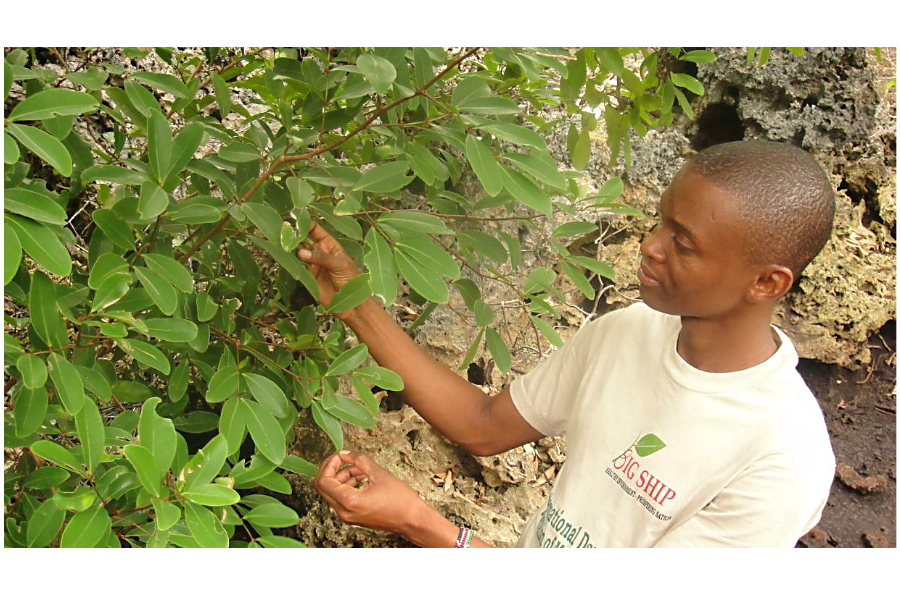Protecting mangroves, Kenya's fishermen net cash – and more fish
Loading...
| Gazi Bay, Kenya
For fishing communities on Kenya's southern coast, felling mangrove trees to make boats has long been a part of life.
But traditional attitudes toward the mangroves are shifting, as communities become aware of a new benefit from keeping the trees standing: cash payments for carbon storage.
Local people who are protecting and replanting mangroves are now selling 3,000 tons of carbon credits a year to international buyers, for about $5-$6 a ton. The money goes into financing more forest protection and restoration, and to community-chosen projects.
"We have rehabilitated Gazi and Makongeni primary schools, bought textbooks for the pupils and provided piped water to the residents in both villages," said Ali Salim, chairman of Mikoko Pamoja (Mangroves Together), the community organization working to protect local mangroves and reap the benefits.
In 2011, residents of Makongeni and Gazi villages – home to about 6,000 people – began working with the Kenya Forest Service and the Kenya Marine and Fisheries Research Institute (KMFRI) to protect 117 hectares (290 acres) of mangroves, or about 20 percent of the mangrove forest in Gazi Bay.
Besides protecting the trees themselves, the effort aims to improve local fisheries, as many species of fish breed and raise their young in shoreline mangroves, and build resilience to worsening storm surges and coastal erosion, which can be slowed by mangroves.
Mangrove forests can also help regulate coastal rainfall, ensuring supplies of water.
But mangrove forests are also particularly effective at absorbing carbon dioxide, one of the major drivers of climate change. James Kairo, a principal scientist at KMFRI, said that mangrove ecosystems can capture five times as much carbon as similar land ecosystems.
In 2013, the Mikoko Pamoja community organization signed an agreement with the Kenya Forest Service to sell carbon credits from the project for 20 years and to plant 4,000 mangrove trees annually to replace those harvested legally or lost to illegal harvesting.
Working with the forest service and KMFRI staff, community members divided the mangrove forest into 10m by 10m plots (about 11 yards by 11 yards), measured the size of the trees in each plot and calculated their rate of growth, to come up with a figure for their carbon storage capacity and to generate carbon credits, explained Salim Mwarima, Mikoko Pamoja's project officer in charge of the carbon offset scheme.
Using that information, the community group has so far earned about $30,000 over two years selling carbon credits to international buyers, who purchase them to offset their own emissions.
The money has been a major motivation for people to become involved in mangrove conservation, said Nafasi Mfahaya, the Kenya Forest Service's ecosystem conservation officer for Kwale County, where Gazi Bay is located.
Salim, the chairman of Mikoko Pamoja, agreed.
"Now people know if we conserve the mangroves, we will have water. (And) if we conserve the mangroves we will have textbooks for the children," he said.
Mangrove cover in Kenya is currently estimated at 50,000-60,000 hectares (about 124,000-148,000 acres), according to a report published this year by the United Nations Food and Agriculture Organization. The FAO says this represents a decline of almost one-fifth since 1985.
Salim, 50, recalls that when he was growing up here on the coast, mangroves were harvested indiscriminately for building houses, making boats and burning as firewood and charcoal.
But gradual awareness of the benefits of mangroves has resulted in more controlled harvesting of the trees.
"If you look at the shoreline (at Gazi Bay) you will realize we still have mangroves within our area of conservation," said Ali Zuberi, a member of the group.
"You also will notice that there are stumps of trees cut a number of years ago. The trees remaining are out of our relentless efforts to inform people about the great significance of ensuring mangroves remain standing," he said.
The United Nations Environment Program estimates that the nearly one-third of the yield of onshore and offshore fisheries in Gazi Bay is related to the presence of the mangroves.
Zuberi, who is himself a fisherman, says that since 2014 – three years after the conservation program began – they no longer return from fishing expeditions with empty nets as they used to.
Instead of mangrove wood, fishermen now use casuarina trees grown on farms in the coastal area to build their boats, Zuberi said.
However, illegal harvesting of mangroves remains a problem that the community and the forest service are trying to tackle.
Under the United Nations Framework Convention on Climate Change, Kenya has committed to reducing emissions of climate-changing gases by 30 percent by 2030.
That goal will be easier to achieve if conservation and preservation of mangroves is integrated into efforts to curb emissions, Kairo said.
Claire Wigg, chief executive officer of Stockholm-based ZeroMission, which buys carbon credits from Mikoko Pamoja and sells them to Swedish companies, said the mangrove carbon offset scheme is popular among its buyers because it is unique and the trees are good performers in carbon sequestration.
A law passed by the Kenyan government in 2005 introduced the concept of community participation in forest conservation, making possible the formation of Mikoko Pamoja. Wigg said she believes the model adopted by the community guarantees the sustainability of the scheme.
ZeroMission "would like to be part of the carbon offset scheme in the long term," Wigg said.
• Reporting by Moraa Obiria; editing by James Baer and Laurie Goering. This story originally appeared on the website of the Thomson Reuters Foundation, the charitable arm of Thomson Reuters that covers humanitarian news, women's rights, trafficking, corruption, and climate change. Visit www.news.trust.org.





